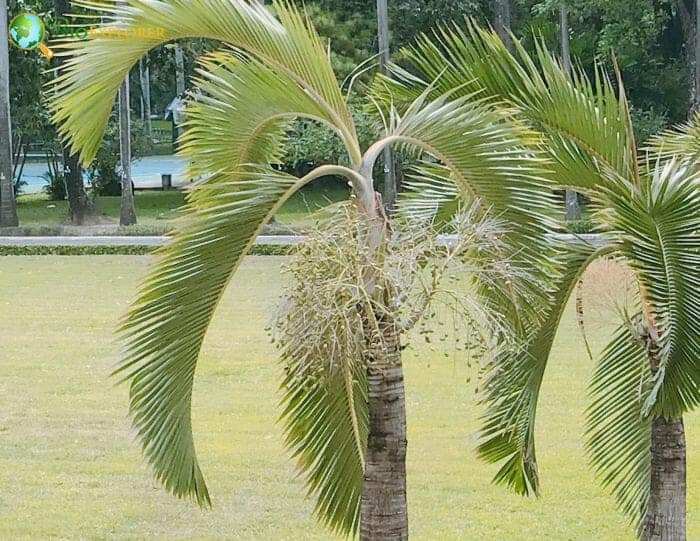
Arecales, the palm order, is one of the most recognizable and significant orders of flowering plants in the tropics and subtropics. Palm trees are economically significant because they provide a wide range of products used for many things.
They are identified by their unusual morphology; in particular, the fan (palmate) or feather (pinnate) leaves are nearly unique in growth.
The Arecales order contains Arecaceae, the most prominent family of monocots, and the Dasypogonaceae family. These two families are comprised of about 989,346 occurrences, 3,865 species in 189 genera[1].
Table of Contents
Arecales Pronunciation
Arecales Distribution

It is also known as the palm tree family. Its many members are limited to tropical and subtropical regions.
- Most are found in rainforests or other humid locations, where they form an essential vegetation component. However, the Arecaceae are found primarily in warm, tropical areas and are typically ecologically significant[2] where they occur.
- Many species of the palm family are endemic to islands. However, the distribution patterns for palms vary, and tribes and subtribes frequently exhibit limited endemism. Consequently, each central geographic region has its own specific endemic group of palms.
- Africa has a low diversity with 60 species. Still, Madagascar, adjacent to it, has over 190 with all but five indigenous.
![]()
Arecales Species

The Amazon rainforest is home to many types of plants.
- A few include the coconut palm (Cocos nucifera), African oil palm (Elaeis guineensis), sago palm (Metroxylon sagu), and date palm (Phoenix dactylifera). In addition, some products are entering international trade, such as carnauba wax (Copernicia prunifera) and raffia (Raphia spp. ).
- In temperate regions, some species such as the chusan palm (Trachycarpus fortune) are cultivated outdoors.
- Other species are used as house plants. In particular, there is an essential trade in species such as golden cane palm (Dypsis lutescens), parlor palm (Chamaedorea elegans), and kentia palm (Howea forsteriana) as pot plants.
![]()
Arecales Characteristics

Members of the order Arecales stand out for a variety of reasons, including the following:
- They are distinctively woody, standing out among the most herbaceous monocotyledonsWhat is monocotyledons?Angiosperm having only one cotyledon. Cotyledon is seed leaf; the first leaf (or set of leaves) to appear during the early development of a seedling. (monocots).
- They have some of the biggest angiosperm leaves (Raphia[jupati]), inflorescences (Corypha), and seeds (Lodoicea[double coconut]).
- Palms are more diverse than other monocotyledons.
- Palms are also unique in that they have the longest fossil record of any plant group. The palms are known to have existed in the Triassic, Jurassic, and Cretaceous periods.
- They were also among the earliest plants to develop compound leaves. However, unlike other seed-bearing plants, palm seeds do not have a tough coating.
- Research has shown that the compound leaves of palms are formed from a single meristem. The meristemWhat is meristem?Specialized groups of cells that are a plant's growing points. creates a simple leaf blade, which then unfolds into multiple pinnae.
- Leaves have a sheathing base, a stalk or petiole (which is generally present), and a folded (plicate) blade that divides along the folds to produce segments or leaflets, giving the overall palmate, pinnate, and/or bipinnateWhat is bipinnate?Twice pinnately compound. shape.
- Their stems are rhizomatousWhat is rhizomatous?Bearing rhizomes. Rhizome is an underground stem, with nodes and short to elongate internodes., lianous, or generally arborescentWhat is arborescent?Becoming tree-like..
- They feature oversized, sheathing, plicate leaves, a fleshy, typically drupaceous fruit, and starch-free seeds.
- The family’s plicate leaf position and drupaceous fruit are most likely apomorphies.
- Their spathes are bracts of various types. Hence, they are not necessarily homologous to each other or to spathes of other monocots. These spathes, which can be extensive and colorful or more leaf-like, serve to protect the flowers and facilitate animal pollination.
Trimerous and tiny flowers are formed on unbranched or heavily branched inflorescences.
- Flowers can be hermaphroditic or unisexual, and if unisexual, they can be borne in the same inflorescence (monoeciousWhat is monoecious?Pertaining to plants, individuals of which bear both staminate and pistillate flowers, but not necessarily perfect flowers.) or in different inflorescences but on the same individual (monoecious) or on separate individuals (monoecious) (dioeciousWhat is dioecious?Pertaining to plants, individuals of which bear either staminate or pistillate flowers, but not both.).
- The perianth is typically biseriate and homochlamydeous, with 3+3[0, 2+2, or ∞], apotepalous segments. Anthers dehisce longitudinally, seldom poricidally. The styles, if present, are distinct or connate, and the stigmas are sessile or at the tips of the styles.
![]()
Arecales Economic Uses

The palm family is essential. It contains several major crop plants such as coconut, African oil palm, sago palm, and date palms.
- Important products entering international trade such as carnauba wax, raffia fiber, rattan, and palm hearts are harvested from wild or semi-cultivated populations of palms.
- Local people use other species for food, building construction, clothing, household utensils, medicine, and ornaments. Unfortunately, these species are only rarely kept track of by the government.
- Most of these products come from wild or semi-cultivated palm populations.
![]()
Palms are an important part of tropical landscaping. They are used extensively in the United States, South Africa, Australia, India, and other countries. Palms are known for their simple beauty and gracefulness.
![]()
















